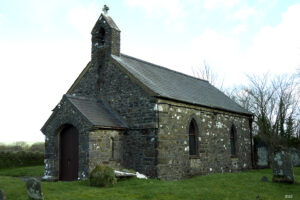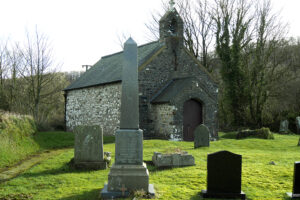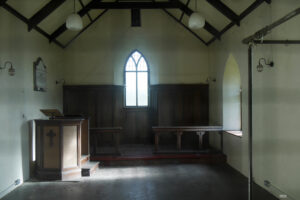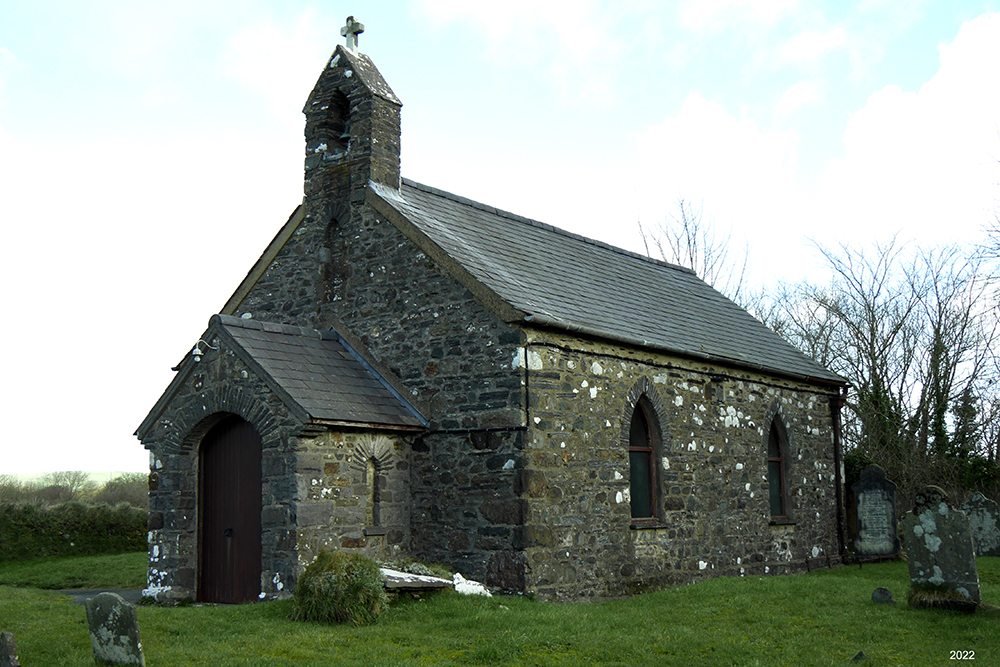


ST MARGARET, FORD, NORTH PEMBROKESHIRE (PRESELI)
Dyfed PRN 2411
RB No. 3214
NGR SM 9581 2580
Not listed (1998)(2021)
SUMMARY
17th century chapel on 17th century site; 0% pre-19th century core fabric. Probably not the site of a medieval chapel.
A 2-cell chapel, small. Consists of chancel/nave, 2 bays; earlier 19th century. West porch, 1920s-1930s. Construction is in limestone rubble throughout. Neo-gothic. All internal walls are rendered/plastered. Slate gable roofs. All openings are earlier 19th century; porch door 1920s-30s.
Roofs and floors, earlier 19th century. Finishes, earlier 19th century.
Condition – good.
Archaeological potential – good-very good. Chapel entirely (re)built in the earlier 19th century, on same location as 17th century chapel; no structural evidence for earlier chapel; large earthwork around 50% of chapel, pre-19th century; shallow external drain around 50% of chapel; no evidence for floor level changes; underfloor void; no crypt/vault evident; no evidence of former components beyond chapel.
Structural value (pre 19th century) – poor. 0% pre 19th century core fabric.
Phasing:
Phase 1 – Nave/chancel, earlier 19th century.
Phase 2 – West porch, 1920s-1930s.
DESCRIPTION
St Margaret, Ford is a 2-celled church (properly a chapel), of small size. It was apparently founded in 1627 as a chapel-of-ease to Hayscastle parish (Fenton, 1903, 182). However, all features of the 17th century chapel have been lost. It was apparently rebuilt shortly before 1786; Bacon’s ‘Liber Regis’ of that year contains the entry ‘…Forde Chapel. Noviter erecta William Knox, Esq.’ (Green, 1911, 299). The chapel as it stands at present is the result of a further rebuild, this time total, apparently of the second quarter of the 19th century – the Diocesan Architect E. H. Lingen Barker, writing in 1887, described it as having been ‘rebuilt within the last 50 years’ (Evans, 1917, 7).
The present chapel contains no pre 19th century core fabric. It consists of a 2-bayed chancel/nave without structural division, from the earlier 19th century rebuild, and a west porch added in the 1920s-1930s (Rev. B. Jones, pers. comm.).
Construction is in medium-sized limestone rubble throughout, rather crude and without quoins or dressings. The contemporary pointing is fair-good. All internal walls are rendered/plastered. Roofs are slated gables, the chancel/nave being roofed continuously; the west porch roof lies at a considerably lower level.
The chancel/nave openings are all earlier 19th century. There is an east window and 2 windows in each of the side walls, all simple 2-centred openings without surrounds with single light timber framed windows. The west door is s similar simple 2-centred opening. The west wall carries a contemporary bellcote, simple and gabled, with a single 2-centred opening. The west porch door of the 1920s-30s is a similar simple opening. The tile floors may be from the later 19th century.
There may be physical evidence for the earlier chapel. A substantial earthwork platform lies south of the chapel, its scarp slope following a semicircular line around it. It is bisected by a deep, wide north-south linear cutting leading up to the centre of the chapel south wall. It appears that the platform may be early, and that the cutting represents a pathway to the south door of either the 17th century chapel, or the rebuilt structure of the later 18th century; there is no structural evidence for a south door in the present building.
A shallow external drain runs along the north and east walls of the chapel. There is no evidence for floor level changes, the former ?path lying at present floor level. There is no evidence for a below-ground crypt or vault, but a shallow underfloor void may be present. There is no evidence of former components beyond the chapel.
The present chapel was not listed in 1998. Not Listed in 2021.
SITE HISTORY
There is no evidence for any pre-conquest religious use of the site.
Ford – as ‘Gybrisford’ – is shown as the site of a possible chapelry on Rees’ map of 14th century Wales (Rees, 1932). However, Fenton states that Ford was ‘a small chapel, originally founded about the year 1627, by Margaret Symmons…for the convenience of her tenants living there, who lay at a very great distance from the parish church of Hayes Castle, Ford being at the very extremity of the parish’ (Fenton, 1903, 182). It was consecrated by the Bishop of St Davids, Theophilus Field, and endowed with a small stipend of £2 per annum to the officiating minister (ibid.). It remained a chapel-of-ease of the parish of Hayscastle, the benefice until recent years being a perpetual curacy, without district assigned (Green, 1911, 298).
By 1800 the chapel had had such an augmentation to its endowment as to entitle it to royal bounty (Fenton, 1903, 182), which was £1200 in 1833 (Lewis, 1833).
In 1998 St Margaret, Ford, was a chapelry in the parish of Hayscastle. The living was a vicarage held with Camrose, St Lawrence and Hayscastle (Benefice 636) of the Archdeaconry of St Davids, Rural Deanery of Roose (St Davids, 1997-8).
The Church in Wales regards Ford Church as dedicated to St Margaret but there appears to be no other source for a dedication; the ‘Margaret’ appellation may have been assumed from the founder’s name.
SOURCES CONSULTED
Map Evidence
NLW, Parish of Hayscastle, Tithe Map, 1842.
Rees, W., 1932, South Wales and the Border in the XIVth century.
Church in Wales Records
St Davids, 1997-8, Diocesan Year Book.
Parish Records, Pembrokeshire Record Office, Haverfordwest
(HPR/48 – Ford)
Printed Accounts
Gordon Partnership, 1993, Redundant Religious Buildings in West Wales.
Evans, G. E., 1917, ‘Parish Churches’, Trans. Carms. Antiq. Soc. Vol 11.
Fenton, R., 1903 edn., A Historical Tour through Pembrokeshire.
Green, F., 1911, ‘Pembrokeshire Parsons’, West Wales Historical Records Vol. I.
Lewis, S., 1833, A Topographical Dictionary of Wales.
Salter, M., 1994, The Old Parish Churches of South West Wales
Updated – February 2022 – PKR.


